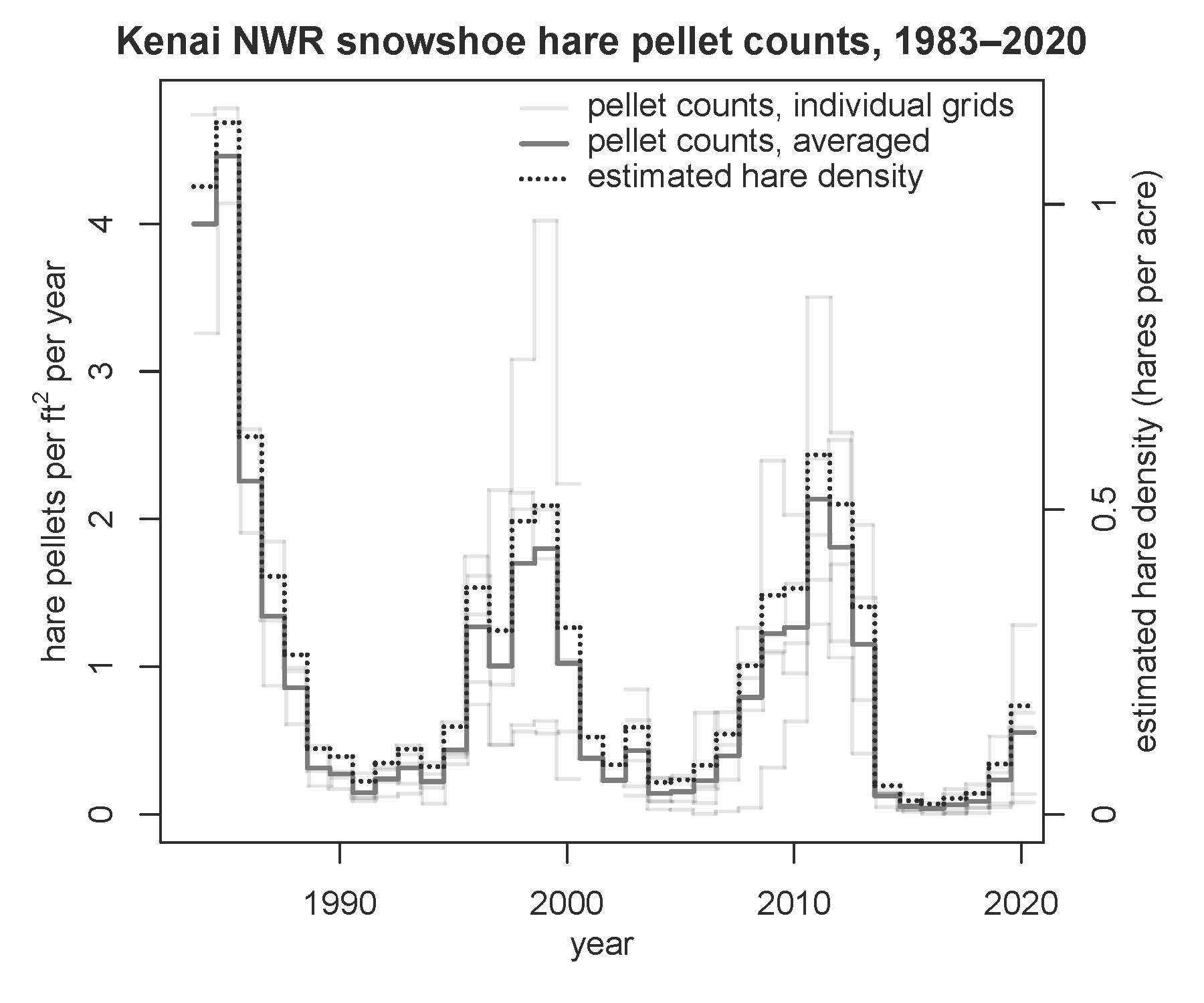If you have been out and about on the northern Kenai Peninsula this summer, you may have noticed a few more snowshoe hares than there were over the previous several years. I know I have been seeing more this year than last year. I have also spotted more spruce grouse this fall.
For at least the past 300 years for which trapping records are available, snowshoe hares have shown a periodic pattern of abundance and scarcity across Canada and Alaska, with peaks in abundance about every 10 years. This cycle is one of the most conspicuous and ecologically important repeating patterns in the boreal forest, intimately involving multiple mammal, bird and plant species, with ripples ramifying out into the food web.
Lynx, coyotes, goshawks and great horned owls respond to increases in hare populations by increasing in turn. As more prey becomes available, predators are able to produce more offspring. Eventually, the snowshoe hare population collapses, leaving the now large population of predators hungry.
For some time we did not know what caused snowshoe hares to decline so precipitously after each population high. Did they run out of food? Did predators cause the decline? Did hares diminish due to disease?
Researchers in the Kluane region of the Yukon were able to answer some of these questions through decades of experiments where they excluded predators from some areas and manipulated food available to hares. They learned that starvation was not the cause of the hares’ declines.
The cycle of rises and falls in hare numbers continued even when the hares were given more food than they could eat. The only way that the hare population could be kept from crashing was to exclude predators, indicating that predators were the driving force behind the decrease part of the hare cycle.
Studies following the lives and deaths of snowshoe hares have found that about 95% of hares die from predation. In short, if you are a hare, it is fairly certain that someday you will be caught and eaten.
Interestingly, it appears that not only is it being eaten by predators, but stress brought on by being searched for by predators that drives part of the cycle. As predators become more abundant, the hares start to produce fewer offspring as the mother hares become stressed by predators chasing them.
This stress grows as the hare population shrinks. Even after predators decline, stress from mothers is somehow passed on to their young, keeping hare populations low for an extended time.
We still do not know what kicks off the increasing part of the hare cycle. Once they get going, though, the hares inevitably out-reproduce their predators for a few years until the predators catch up.
It is believed that predators are also the cause of rolling waves of hare cycles that repeatedly pass over Canada and Alaska.
When hares decline in one region, lynx and other predators wander large distances in search of food. By doing so, they cause cycles of hare and predator abundance to move along as a wave. On the Kenai Peninsula, our last two peaks in hare abundance have happened about one to two years after peaks in Interior Alaska.
The snowshoe hare population cycle affects some boreal forest species indirectly. Since at least the 1950s, it has been noted that grouse populations often peak just before hare populations. This pattern has been confirmed in recent years.
Spruce grouse, ruffed grouse, ptarmigan and hares share some of the same predators. As populations of hares and their predators rise, the larger numbers of predators find and consume more of these ground-nesting birds.
Wildfire, another conspicuous cyclical event in the boreal forest, does not disrupt the snowshoe hare cycle, but fires can affect how high the peaks are. Hares can reach high densities in recently burned forests, where young hardwoods and shrubs provide ample food.
Because the hare cycle is such an integral part of the way our system works, Kenai National Wildlife Refuge biologists have been monitoring hare densities since 1983. Every year we count hare pellets (poop) on several grids of small plots located in the Swanson River, Funny River and Skilak Lake Road areas.
After counting them we remove the pellets so that they will not be counted again the next year. This gives us a measure of hare pellets per square foot per year, from which we can get a rough estimate of the number of hares per acre.
This year (pellets deposited from summer 2019 to summer 2020) we counted an average of about one pellet for every 2 square feet, from which we estimate that there were about one hare for every 6 acres over that time period. This is much higher than the recent low of one hare per 40 to 60 acres over 2014 to 2017 and lower than the last high of one hare for every two acres over 2010 to 2012.
Based on where we are in the hare cycle, we expect snowshoe hare populations to continue to rise and then peak in the next few years. We may see large numbers of hares in the Funny River Fire burn, where dense regrowth of hardwoods should provide plenty of browse for hares.
Photographers, hunters and trappers should be able to find more of the hares and their predators as they increase in numbers over the next few years. At the same time, gardeners should be thinking of protecting valuable plants from hungry hares.
Living where we are in the boreal forest, it is good to know where we are in this natural cycle of abundance and scarcity of the snowshoe hare.
Matt Bowser serves as Fish and Wildlife Biologist at Kenai National Wildlife Refuge. Find more Refuge Notebook articles (1999–present) at https://www.fws.gov/refuge/Kenai/community/refuge_notebook.html.
By MATT BOWSER
Kenai National Wildlife Refuge

